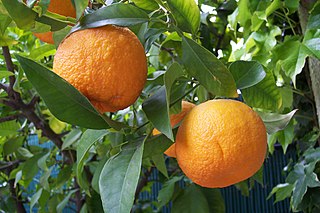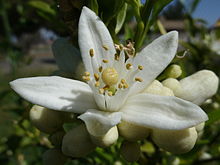
Mexican cuisine consists of the cooking cuisines and traditions of the modern country of Mexico. Its earliest roots lie in Mesoamerican cuisine. Its ingredients and methods begin with the first agricultural communities such as the Olmec and Maya who domesticated maize, created the standard process of nixtamalization, and established their foodways. Successive waves of other Mesoamerican groups brought with them their cooking methods. These included: the Teotihuacanos, Toltec, Huastec, Zapotec, Mixtec, Otomi, Purépecha, Totonac, Mazatec, Mazahua, and Nahua. With the Mexica formation of the multi-ethnic Triple Alliance, culinary foodways became infused.

Calamansi, also known as kalamansi, calamondin, Philippine lime, or Philippine lemon, is an economically important citrus hybrid predominantly cultivated in the Philippines. It is native to the Philippines, parts of Indonesia, Malaysia, and Brunei, as well as parts of southern China and Taiwan.
Perfume is a mixture of fragrant essential oils or aroma compounds (fragrances), fixatives and solvents, usually in liquid form, used to give the human body, animals, food, objects, and living-spaces an agreeable scent. Perfumes can be defined as substances that emit and diffuse a pleasant and fragrant odor. They consist of manmade mixtures of aromatic chemicals and essential oils. The 1939 Nobel Laureate for Chemistry, Leopold Ružička stated in 1945 that "right from the earliest days of scientific chemistry up to the present time, perfumes have substantially contributed to the development of organic chemistry as regards methods, systematic classification, and theory."

Marmalade is a fruit preserve made from the juice and peel of citrus fruits boiled with sugar and water. The well-known version is made from bitter orange. It is also made from lemons, limes, grapefruits, mandarins, sweet oranges, bergamots, and other citrus fruits, or a combination. Citrus is the most typical choice of fruit for marmalade, though historically the term has often been used for non-citrus preserves.

Bitter orange, sour orange, Seville orange, bigarade orange, or marmalade orange is the citrus tree Citrus × aurantium and its fruit. It is native to Southeast Asia and has been spread by humans to many parts of the world. It is probably a cross between the pomelo, Citrus maxima, and the mandarin orange, Citrus reticulata.

The pomelo, from the family Rutaceae, is the largest citrus fruit, and the principal ancestor of the grapefruit. It is a natural, non-hybrid, citrus fruit, native to Southeast Asia. Similar in taste to a sweet grapefruit, the pomelo is commonly consumed and used for festive occasions throughout Southeast Asia. As with the grapefruit, phytochemicals in the pomelo have the potential for drug interactions.

Yuzu is a citrus fruit and plant in the family Rutaceae of East Asian origin. Yuzu has been cultivated mainly in East Asia, though recently also in New Zealand, Australia, Spain, Italy, and France.

The Seaboard Air Line Railroad, which styled itself as "The Route of Courteous Service", was an American railroad that existed from April 14, 1900, until July 1, 1967, when it merged with the Atlantic Coast Line Railroad, its longtime rival, to form the Seaboard Coast Line Railroad. Predecessor railroads dated from the 1830s and reorganized extensively to rebuild after the American Civil War. The company was headquartered in Norfolk, Virginia, until 1958, when its main offices were relocated to Richmond, Virginia. The Seaboard Air Line Railway Building in Norfolk's historic Freemason District still stands and has been converted into apartments.

Neroli oil is an essential oil produced from the blossom of the bitter orange tree. Its scent is sweet, honeyed and somewhat metallic with green and spicy facets. Orange blossom is also extracted from the same blossom and both extracts are extensively used in perfumery. Orange blossom can be described as smelling sweeter, warmer and more floral than neroli. The difference between how neroli and orange blossom smell and why they are referred to with different names, is a result of the process of extraction that is used to obtain the oil from the blooms. Neroli is extracted by steam distillation and orange blossom is extracted via a process of enfleurage or solvent extraction.

A buñuelo (Spanish:[buˈɲwelo]; alternatively called boñuelo, bimuelo, birmuelo, bermuelo, bumuelo, burmuelo, or bonuelo is a fried dough fritter found in Spain, Latin America, and other regions with a historical connection to Spaniards, including Southwest Europe, the Balkans, Anatolia, and other parts of Asia and North Africa. Buñuelos are traditionally prepared at Christmas. It will usually have a filling or a topping. In Mexican cuisine, it is often served with a syrup made with piloncillo.

Tea blending is the act of blending different teas together to produce a final product that differs in flavor from the original tea used. This occurs chiefly with black tea, which is blended to make most tea bags, but it can also occur with such teas as Pu-erh, where leaves are blended from different regions before being compressed. The most prominent type of tea blending is commercial tea blending, which is used to ensure consistency of a batch on a mass scale so that any variations between different batches and seasons of tea production do not affect the final product. However, it is also common to blend tea leaves with herbs and spice, either for health purposes or to add interesting and more complex flavor notes. It is important that any one blend must taste the same as the previous one, so a consumer will not be able to detect a difference in flavor from one purchase to the next.

Escabeche is the name for a number of dishes in Spanish, Portuguese, Filipino and Latin American cuisines, consisting of marinated fish, meat or vegetables, cooked or pickled in an acidic sauce, and colored with paprika, citrus, and other spices.

An orange is a fruit of various citrus species in the family Rutaceae ; it primarily refers to Citrus × sinensis, which is also called sweet orange, to distinguish it from the related Citrus × aurantium, referred to as bitter orange. The sweet orange reproduces asexually ; varieties of the sweet orange arise through mutations.

Fragrance extraction refers to the separation process of aromatic compounds from raw materials, using methods such as distillation, solvent extraction, expression, sieving, or enfleurage. The results of the extracts are either essential oils, absolutes, concretes, or butters, depending on the amount of waxes in the extracted product.

The Orange Blossom Special was a deluxe passenger train on the Seaboard Air Line Railroad connecting railroads between New York City and Miami in the United States. It ran during the winter season only.

Orange flower water, or orange blossom water, is a clear aromatic by-product of the distillation of fresh bitter-orange blossoms for their essential oil.

Eau de toilette is a lightly scented perfume. It is also referred to as aromatic waters and has a high alcohol content. It is usually applied directly to the skin after bathing or shaving. It is traditionally composed of alcohol and various volatile oils. Traditionally these products were named after a principal ingredient; some being geranium water, lavender water, lilac water, violet water, spirit of myrcia and 'eau de Bretfeld'. Because of this, eau de toilette was sometimes referred to as "toilet water".
"Orange Blossom Special" is a fiddle tune about the luxury passenger train of the same name. The song was written by Ervin T. Rouse (1917–1981) in 1938 and was first recorded by Rouse and his brother Gordon in 1939. Often called simply "The Special" or "OBS", the song is commonly referred to as "the fiddle player's national anthem".

Citrus × aurantium f. aurantium(Syn: Citrus× sinensis), a hybrid between pomelo and mandarin, also known as the sweet oranges, is a commonly cultivated species of orange that includes Valencia oranges, blood oranges and navel oranges.
The Inland Lakes Railway, later known as Florida Rail Adventures, was a tourist railroad located in the northwestern portion of Central Florida. The railway operated several excursion trains ranging from a five course dinner train to sightseeing excursions throughout Lake and Orange Counties. The company operated through a lease agreement with the Florida Central Railroad, the owner of the tracks. Trains operated between the towns of Mount Dora, Tavares, Eustis, Lake Jem, and Orlando.



























